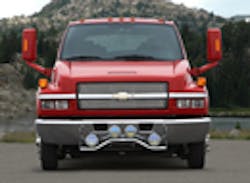Though details regarding the sales of General Motor’s medium-duty truck business to Navistar, the parent company of International Truck & Engine Corp., remain thin at this point, analysts think it’s a good deal for both companies.
“It’s an opportunity for International to really expand its presence in the Class 3-5 midrange market,” Chris Brady, president of Commercial Motor Vehicle Consulting (CMVC), told FleetOwner.
“International doesn’t have a strong presence in that area and there’s much more growth going on there compared to the Class 6-7 segment,” he said. “Another good thing is that GM recently redesigned its product, so International is not getting something old it must update quickly – it has time to work with it.”
“In general, this is not a bad deal at all,” Eric Starks, president of equipment market analytical firm FTR Associates, told FleetOwner. “It’s a really good way for GM to stop building medium-duty trucks without letting that business fall off the face of the earth. This way, they are taking care of their customer base.”
The sale, valued by Bear Stearns analysts at $500 million, comes at a critical time for GM. According to the Detroit Free Press, the automaker sold more than $21 billion in assets over the past three years, posting net losses of $50 billion, including a $39 billion charge in the third quarter alone of this year to cover tax accounting changes. In August, GM sold Allison Transmission to buyout firms Carlyle Group and Onex Corp. for $5.6 billion.
“They might as well monetize one more non-strategic asset to fund the turnaround,” Pete Hastings, a fixed-income analyst at Morgan Keegan & Co., told the Detroit Free Press. “GM doesn’t have a liquidity problem, but adding more coins to the coffers is never a bad thing.”
“This will enable GM to allocate more resources on its core: cars and light trucks,” noted auto analyst C. Leonard Bauer, formerly of Prudential. “I like the sale to Navistar in that it gets GM out of a space that did not represent a big gainer. GM has seen the future, and for them it's not in manufacturing mid-size trucks.”
According to industry estimates, the deal should add $1.5 billion or more to International’s top line revenues. It should fit well with its growth strategy, leveraging GM’s and International’s medium-duty product lines to gain scale and improving International’s manufacturing cost structures.
“This may really help them with their cost structure, but the biggest thing for International is that it solidifies them as the mid-range leader,” FTR’s Starks said. “They’ve always been a key player – now they are the big boys on the block.”
One expected casualty of this deal is International’s relationship with Ford Motor Co., already on the rocks over several issues. Though the two have been involved in joint venture to build Class 3-5 cabover trucks since 2001, they’ve been at loggerheads over diesel engines. International, the exclusive diesel engine supplier for Ford’s heavy-duty pickups since 1979, stopped production of its 6.4 liter PowerStroke back in February in a pricing dispute with Ford and only restarted making them under a court order. The issue isn’t minor, as 40% of the 796,039 F-Series trucks Ford sold in 2006 were equipped with International-brand diesel engines.
“Ford’s bread and butter in the commercial market is Class 3-5, and now International will be going head-to-head with them,” CMVC’s Brady said. “In my opinion, there’s a lot of animosity between them, and my gut tells me Ford may opt out of their diesel engine contract when it comes up for renewal.”
But Brady stresses that International didn’t buy GM’s medium-duty business just to support its mid-range diesel engine sales. “They are looking at that Class 3-5 market and are seeing a lot of growth, especially over the last 10 years, compared to their relatively more mature Class 6-7 segment, which is growing maybe between 3% and 4% a year. They see this as an opportunity to get into that Class 3-5 segment with a competitive product relatively inexpensively. It’s a no-brainer for them.”
About the Author
Sean Kilcarr
Editor in Chief
Sean Kilcarr is a former longtime FleetOwner senior editor who wrote for the publication from 2000 to 2018. He served as editor-in-chief from 2017 to 2018.
